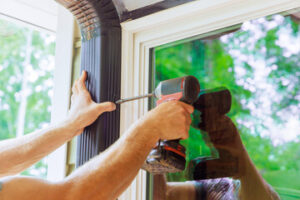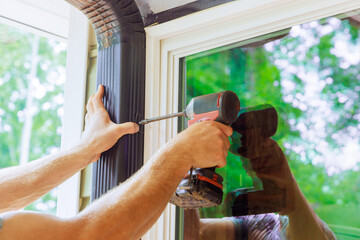Gutter systems help protect homes from water damage by channeling rainwater away from walls, roofs, and foundations. However, the installation process requires careful planning and attention to detail to ensure a quality result.
Gutter replacement projects can take anywhere from a few hours to a few days to complete. The timeline is contingent on several factors, including the size of the home and the type of gutters selected. Contact Gutter installation Gainesville FL for professional help.
Gutter systems help to safeguard a home’s foundation, siding, and landscaping from water damage. Investing in an expertly installed system is crucial to preventing costly repairs and preserving optimal roof performance.
Although gutter installation may seem like a simple task, the reality is that this project requires careful planning and precise execution. A lack of attention to detail can result in a faulty gutter system that leaks, causes water damage, or even fails altogether. This is why homeowners who choose to tackle this project should be well-versed in the basics of gutter installation.
The first step in the gutter installation process is choosing the proper materials. There are a number of factors that influence this decision, including local weather conditions, budget constraints, and the architectural style of a property. Each material has its pros and cons, so it is important to carefully consider each option before making a final decision.
Once the right materials have been selected, it is time to start preparing for the project. Begin by gathering the necessary tools and equipment, including a ladder, tin snips, and waterproof gutter sealant. A ladder is essential for accessing the roofline, and tin snips are used to make the precise cuts required for proper gutter installation. Waterproof gutter sealant is also a must, as it helps to prevent leaks and ensure that the joints between gutter sections are watertight.
Before beginning the actual work, it is a good idea to take a tape measure and record the length of each gutter section along the roofline. This will help to ensure that the finished gutter system is properly sized and that each downspout outlet is positioned correctly. A downspout should be located every 30 to 40 feet, and it is important that the gutters are angled away from a home’s foundation.
After the gutters have been installed, they should be thoroughly tested for leaks and proper flow. A hose should be used to check that the gutters are draining properly and that water is not being directed toward walkways or into a basement. If any problems are identified, they can be easily fixed before the issue becomes more severe. Regular cleaning and maintenance are also important for extending the lifespan of a gutter system.
Getting Started
A successful gutter installation starts with a plan. Guttering is more than just attaching troughs to your roof; it requires design to maximize efficient water runoff and safe drainage away from your home. A roofing contractor understands the intricacies of this process and has the right tools to make it happen.
When planning a gutter installation, make sure to evaluate your roof to establish critical factors such as size and dimensions. This will help you to shop for guttering components that will fit your house perfectly. You may also want to sketch your roof to visualize the project. This will help you to plan for downspout locations, end caps, and other important details.
You should also check the weather conditions before starting to install gutters. If it’s too windy or rainy, you might not be able to work safely. Moreover, it’s better to have a spotter on hand during the entire process, especially when working with ladders. This ensures that someone can hold the ladder securely and will be ready to help out in case a part of the gutter falls off or becomes unsteady.
Before putting up the gutters, you should inspect the fascia and soffits to see if they’re in good condition. If you find rotting wood or mildew, replace them before attempting to put up the gutters. You should also prime and paint the bare wood, as this protects the house and helps to prolong the life of your gutters.
Once the wood is prepped, you’re ready to start installing the gutters. First, you should mark the positions for the gutter brackets on the fascia board. They should be spaced about 24 to 36 inches apart. Next, you should install the brackets and secure them with stainless steel lag screws that are at least two inches long.
Once the gutters are in place, you can install the downspouts and outlets. To do this, you should first locate the lowest point of the gutter run. This should be 14 inch vertical drop for every 10 feet of gutter. You should then cut holes in the gutters to connect them with downspouts and outlets.
Preparing for the Job
Gutters are an important part of your home, directing rainwater away from your foundation, siding, landscaping, and basement. Without gutters, water runoff can cause serious damage to your home over time. However, gutter installation can be a complicated task for homeowners who aren’t familiar with this project. It’s important to follow the right steps to ensure your gutters are installed correctly, safeguarding your home for years to come.
The first step in a gutter installation is to prepare the work area. This means gathering all of the necessary tools and materials to get started. This will include a ladder, measuring tape, drill, level, hacksaw or tin snips, gutter sections, hangers, downspouts, elbows, and sealant. It’s also a good idea to have someone with you when working up a ladder. This will keep you safe from falls and can help you when it comes to removing old gutters or installing new ones.
Depending on the condition of your existing gutters, you may want to consider a full or partial installation. A partial install can be a cost-effective solution and provide targeted protection, while a full gutter system offers comprehensive defense against water damage. Both options have their advantages and disadvantages, so it’s best to consult a professional who can help you determine what option will be most beneficial for your home.
Before starting to install your new gutters, it’s important to remove any existing ones that are sagging or damaged. Care should be taken when removing these gutters to avoid damaging the fascia boards, roof, and walls of your home. It’s best to start at the bottom of the gutter and work your way up, taking care to remove any nails or screws that are holding the gutter in place.
Once all of the old gutters are removed, you’ll need to mark where the downspouts will be placed on the lowest section of your roof. This will make it easier to attach the new gutters once they’re ready to be installed. You’ll also want to test the flow of water through your gutters by spraying them with a hose. This will help you to identify any leaks or areas that need to be sealed.
Installation
As with any home improvement project, preparation is essential to a successful outcome. Gutter installation is no exception, as it requires accurate measurements and proper positioning to ensure effective home drainage. It also involves determining the proper downspout location and size, as this is what effectively directs water away from the foundation of your home.
Gutter installation can be a complicated endeavor and will likely require some time to complete correctly. There are many external factors that will impact the timeline, including weather conditions. Rain, wind, and other environmental factors can delay the work or even force it to be halted temporarily. Clear communication between the homeowner and installer is important to manage these challenges effectively.
It is also important to consider the type of gutter you will install. Both partial and full installations have their advantages, depending on your needs, budget, and the current condition of your gutters. The installation process can be accelerated by having the necessary materials ready before starting. This includes covering any areas that will be exposed to water with a waterproof sealant.
During the installation process, it’s essential to take a step back and evaluate your progress. If you notice any mistakes, it’s vital to address them before continuing. Common mistakes include using the wrong materials or improperly measuring the roofline. Taking the time to correct these issues can prevent costly repairs down the road.
After the gutters are installed, it’s time to test them for leaks and proper function. Run a hose over the gutters to make sure that they are secure and water flows as it should. If you notice any spots where the gutters might leak, it’s a good idea to apply some waterproof gutter sealant and let it dry fully before testing again.
Gutter installation is an affordable, rewarding DIY project that helps to safeguard your home and protect your landscaping from damage. However, it’s always best to hire a professional to ensure the highest level of workmanship. A trusted gutter installation company will ensure that your gutters are positioned properly and designed to last for years to come.
